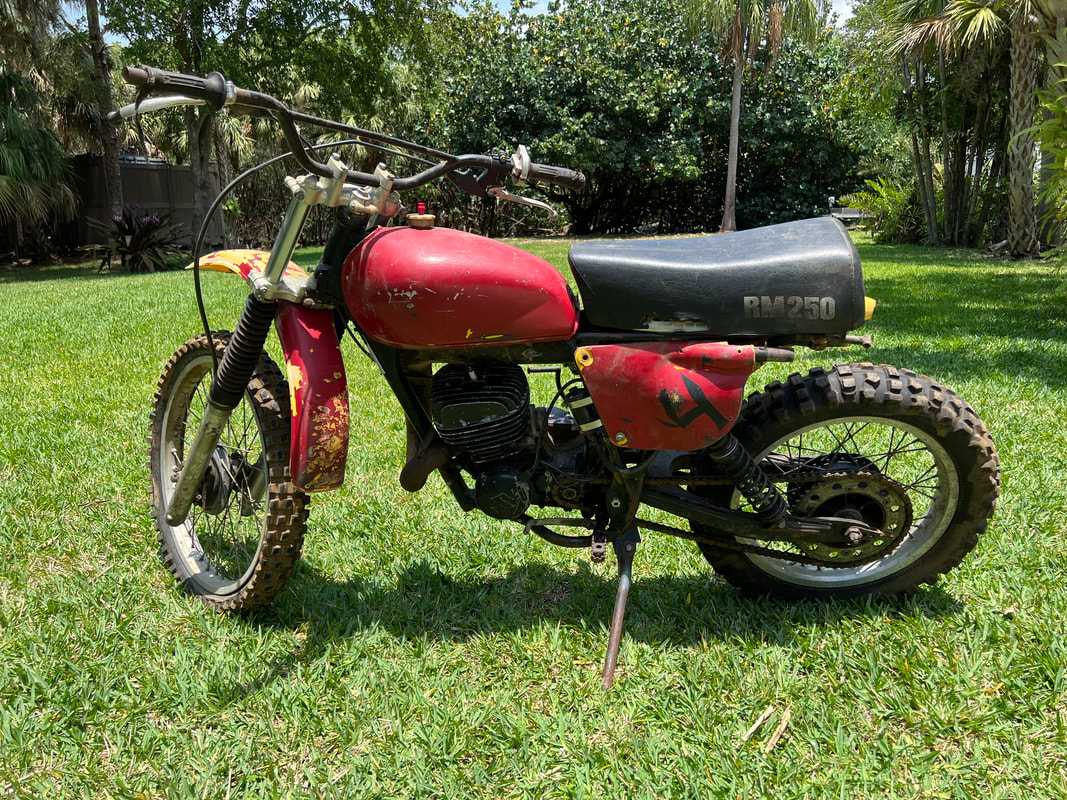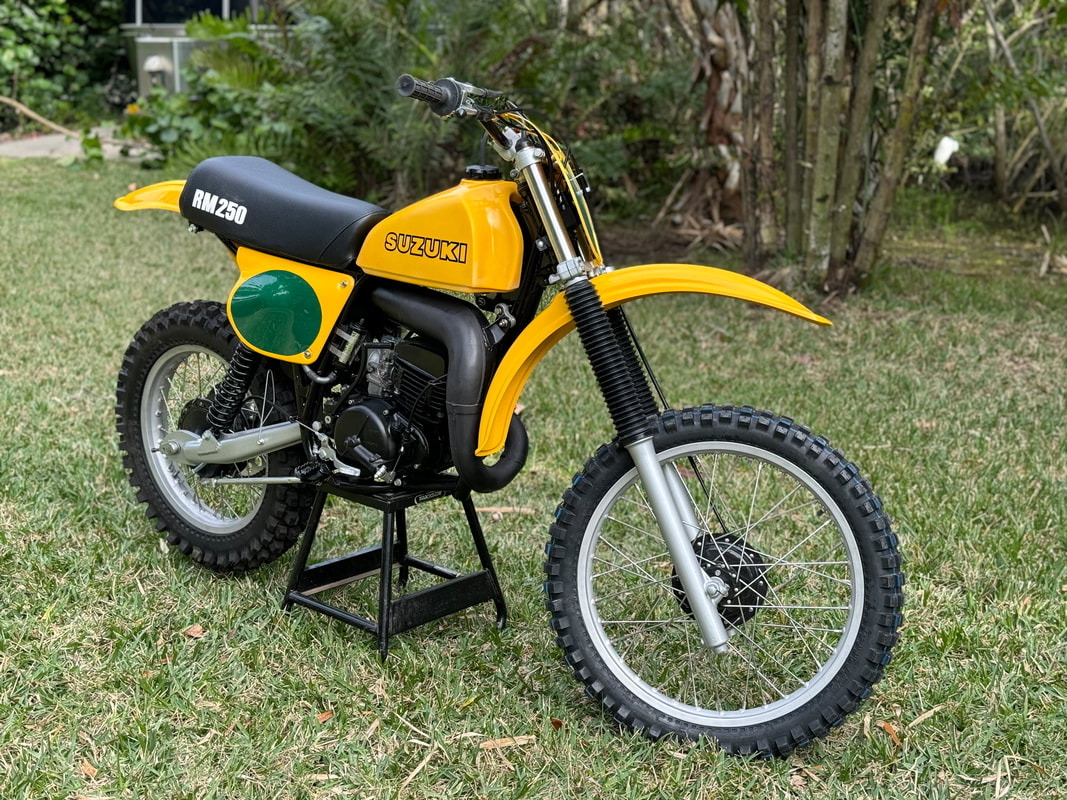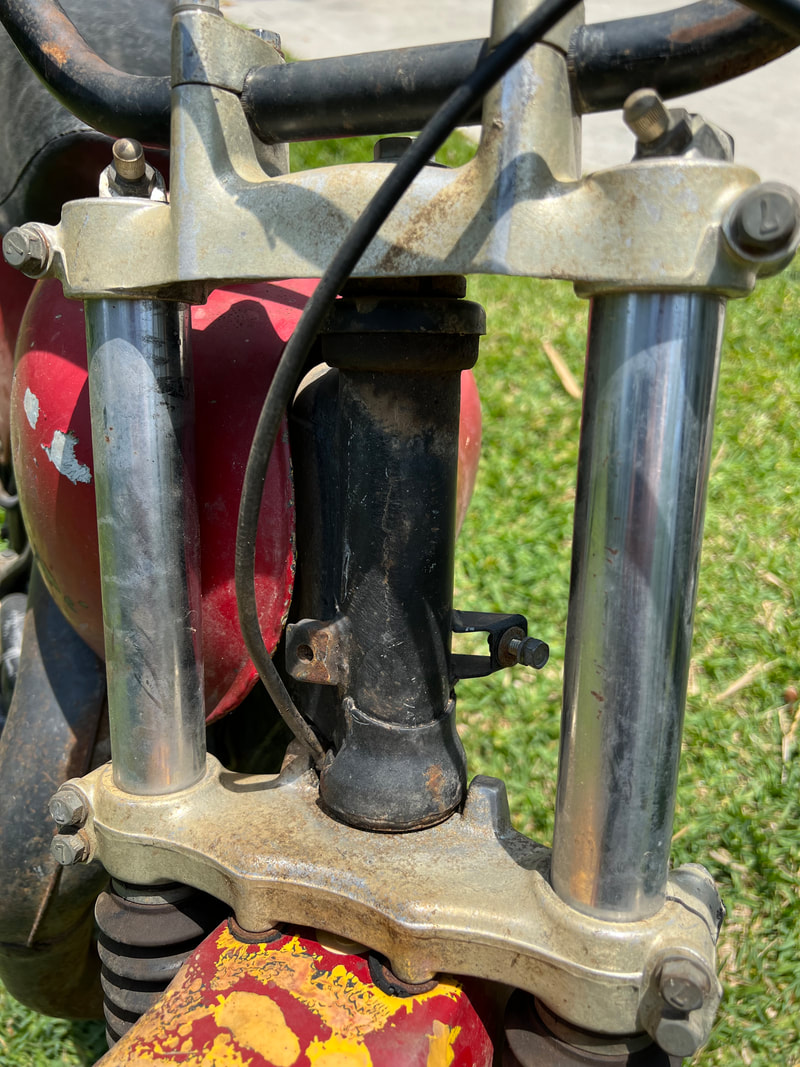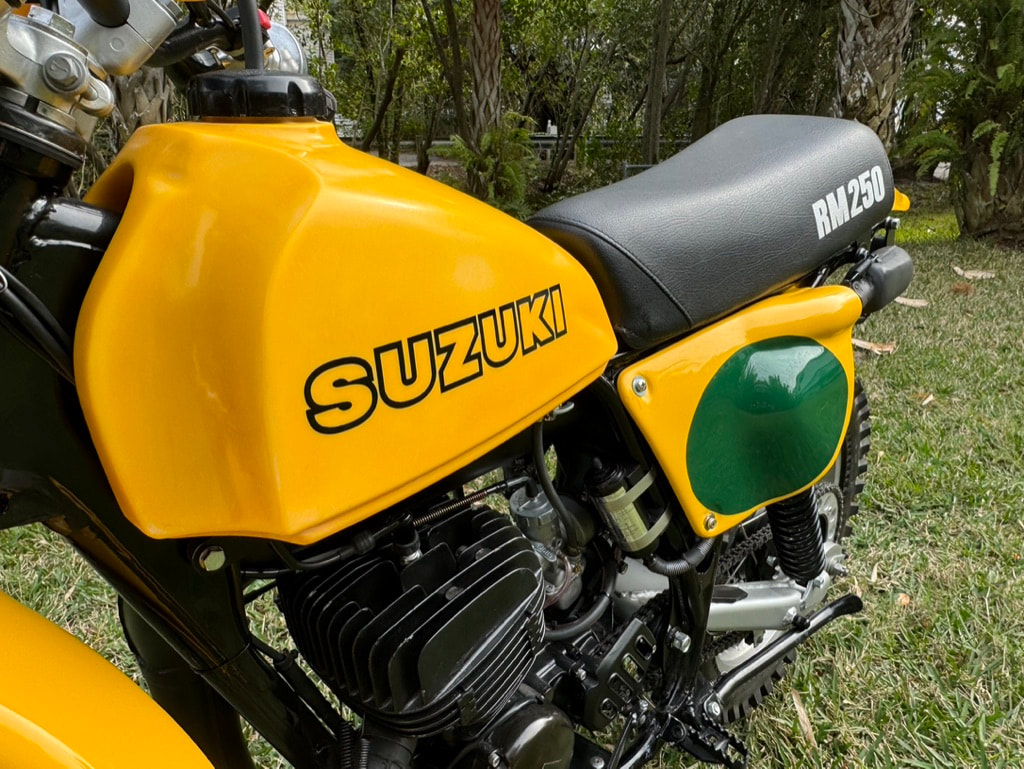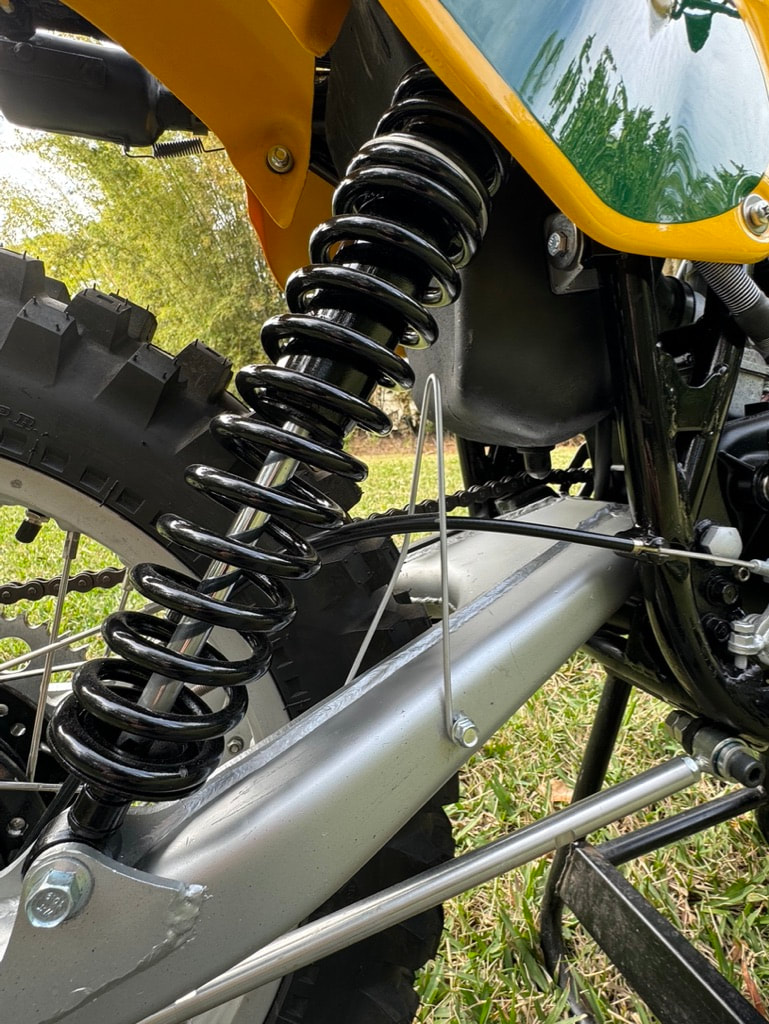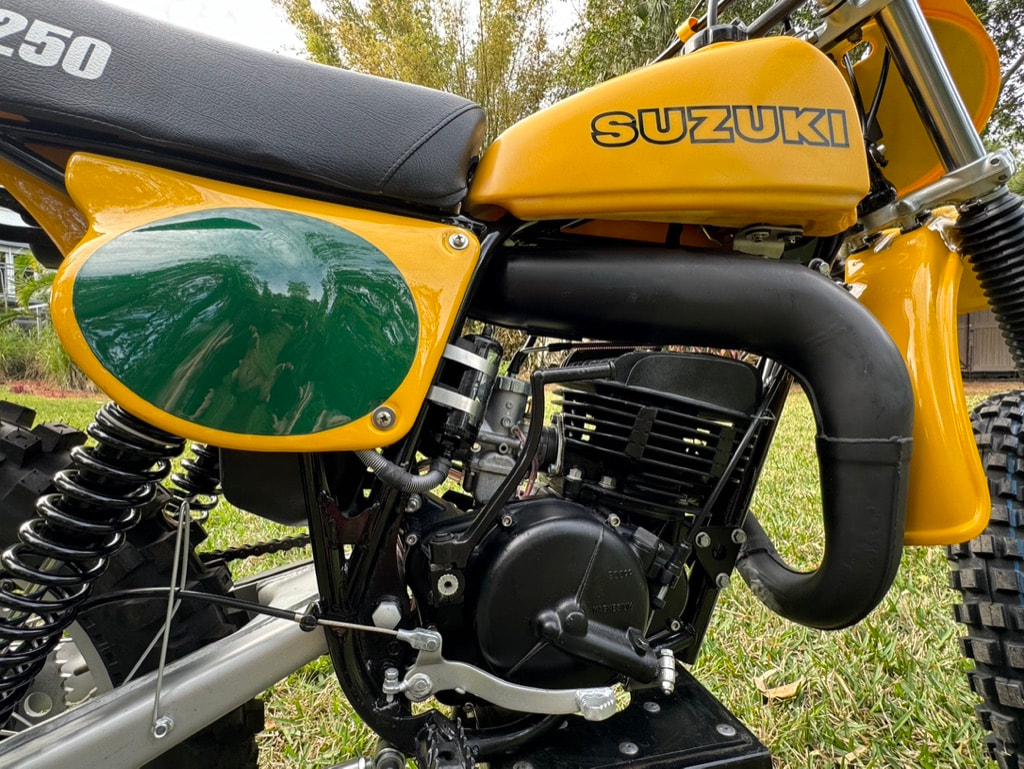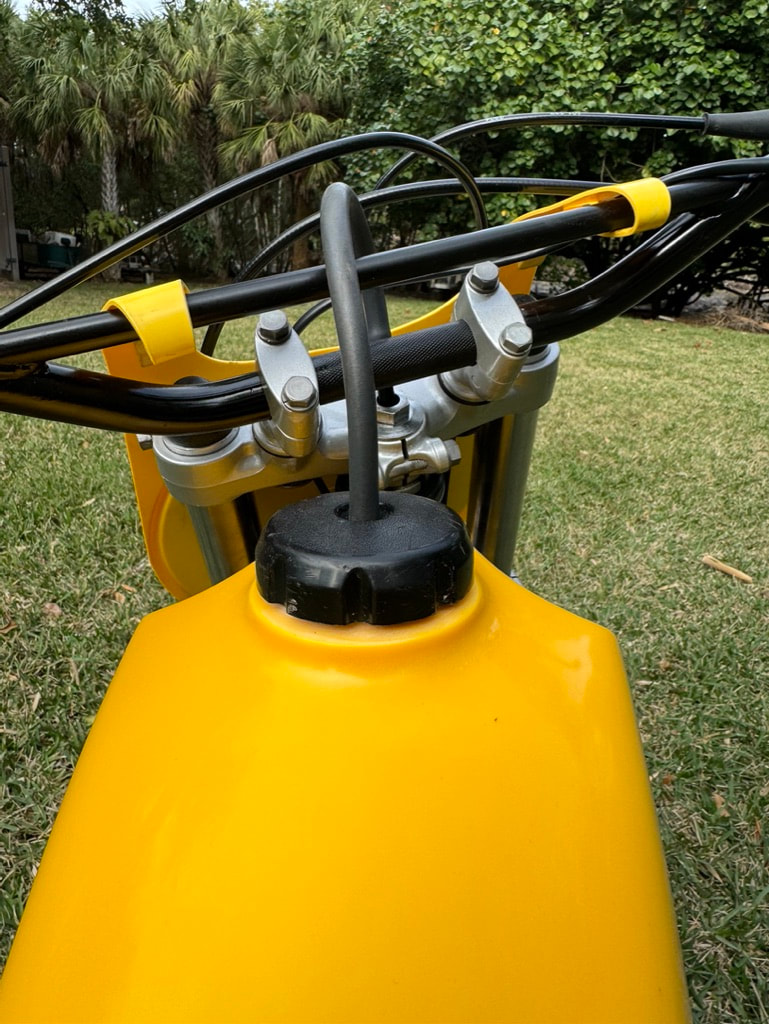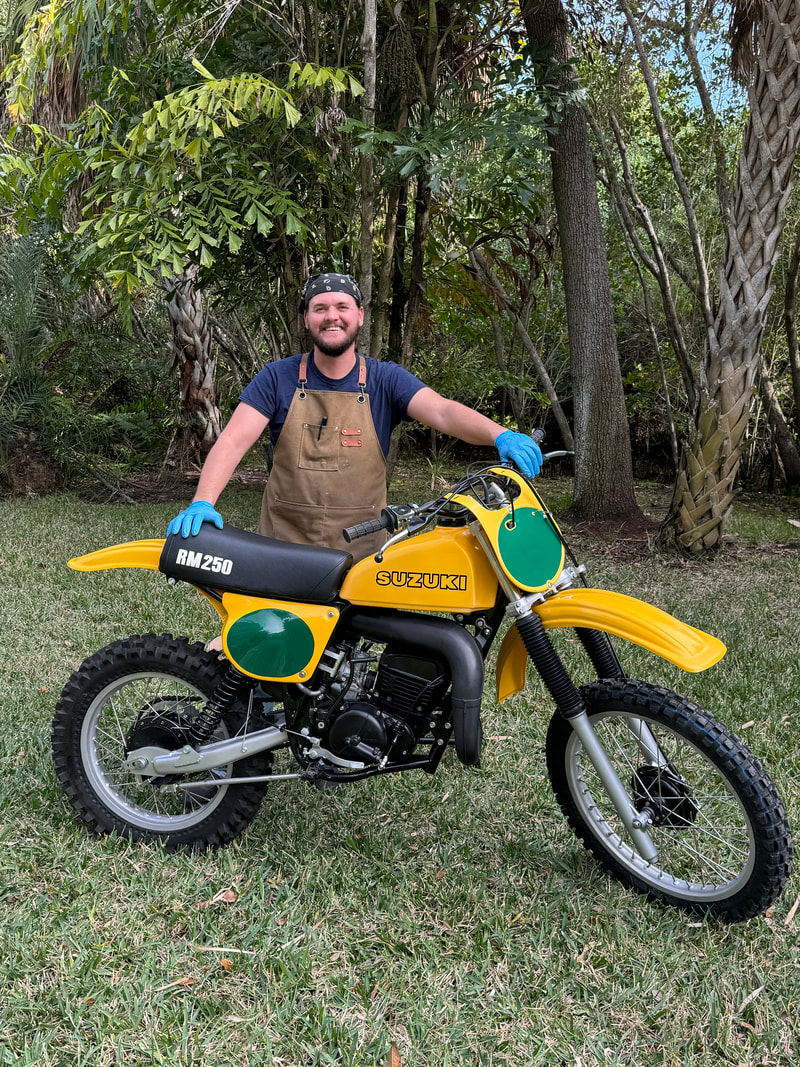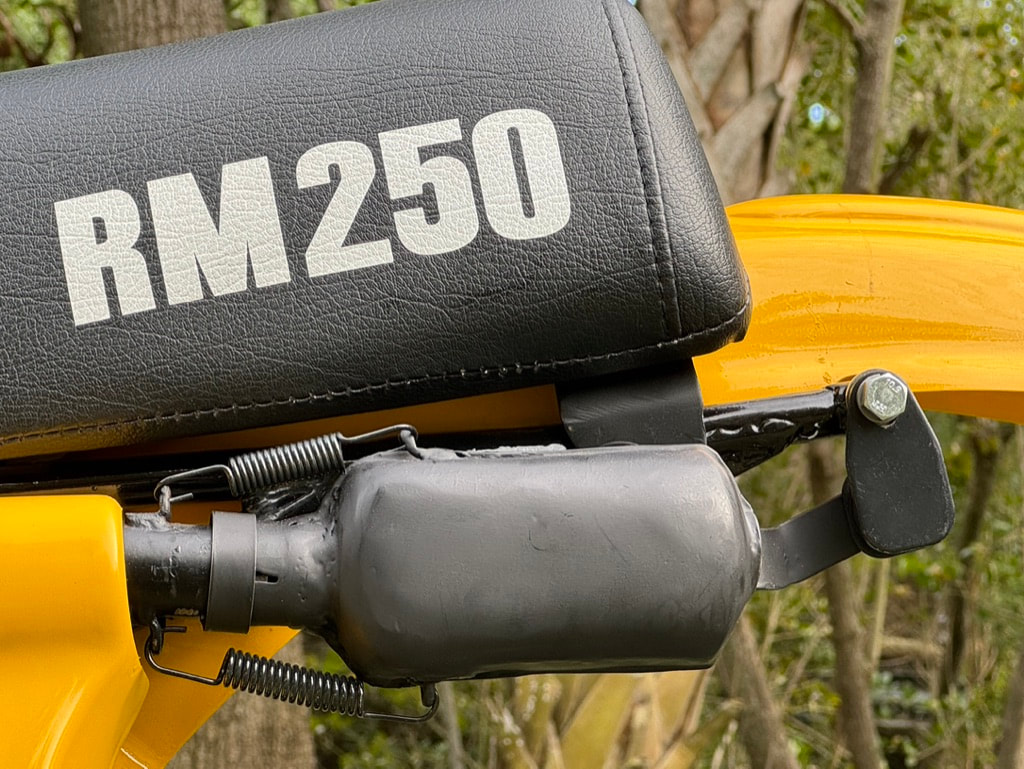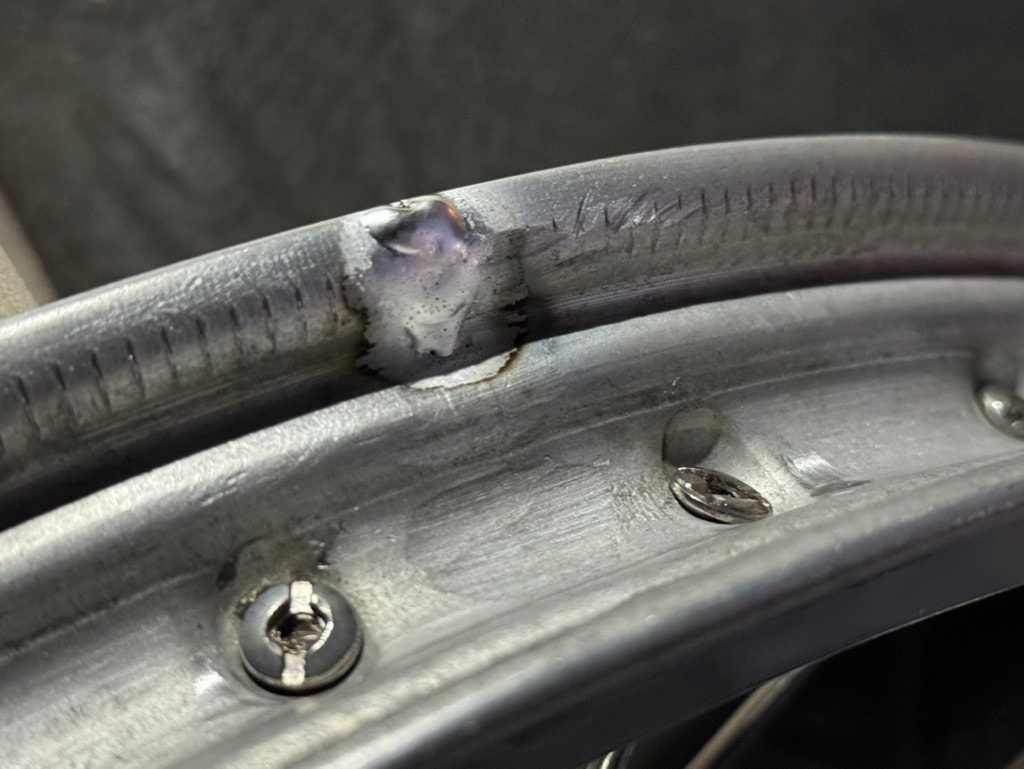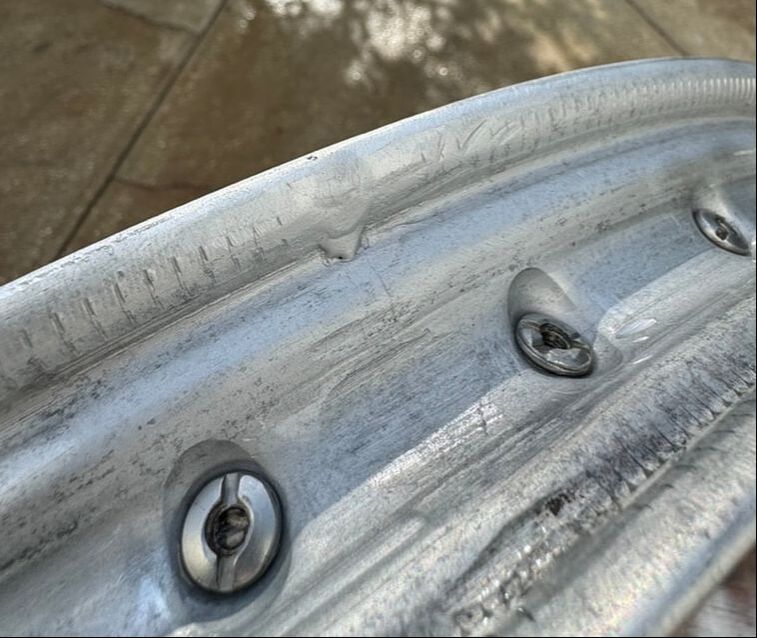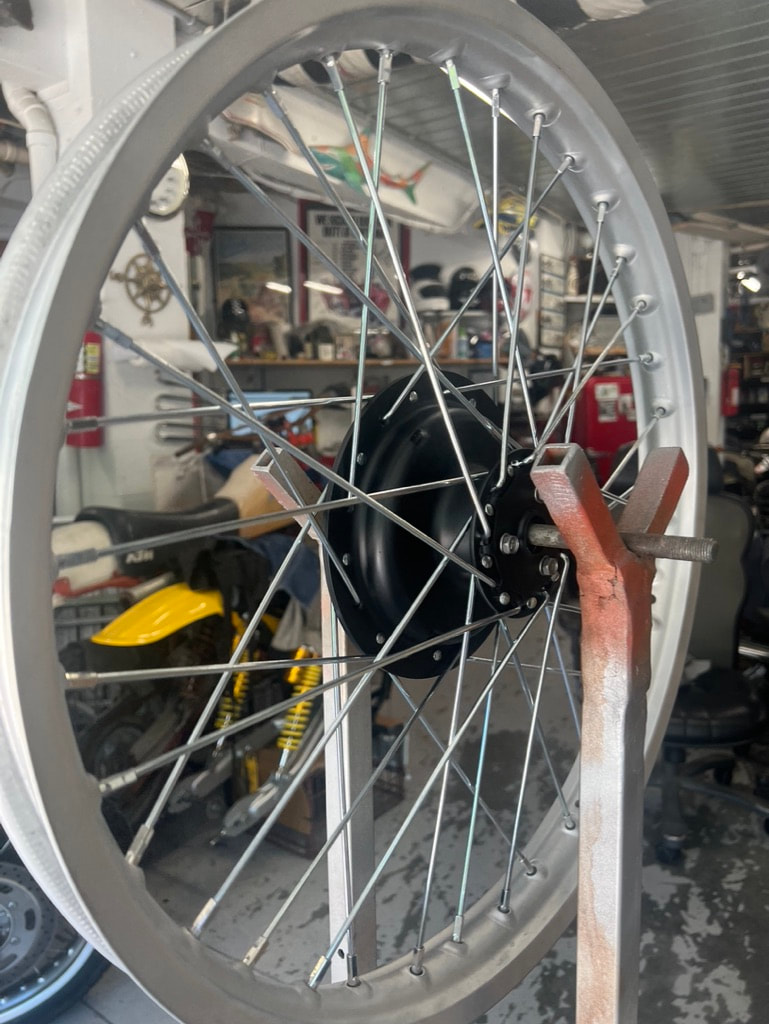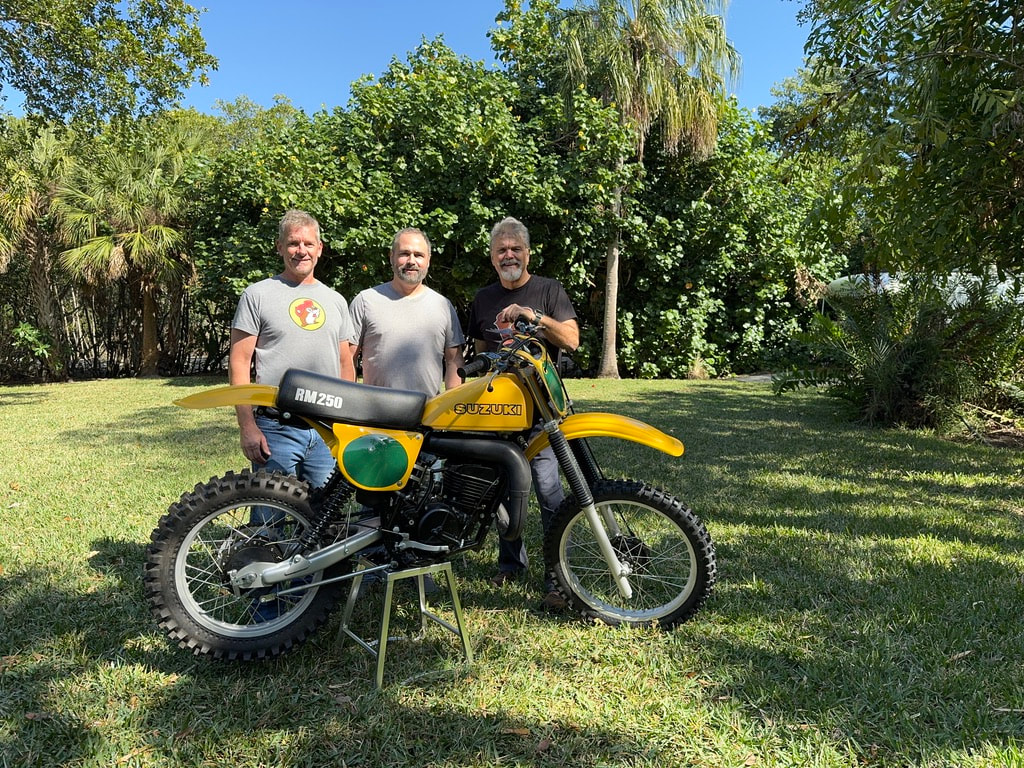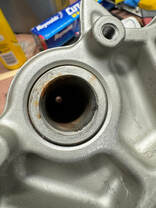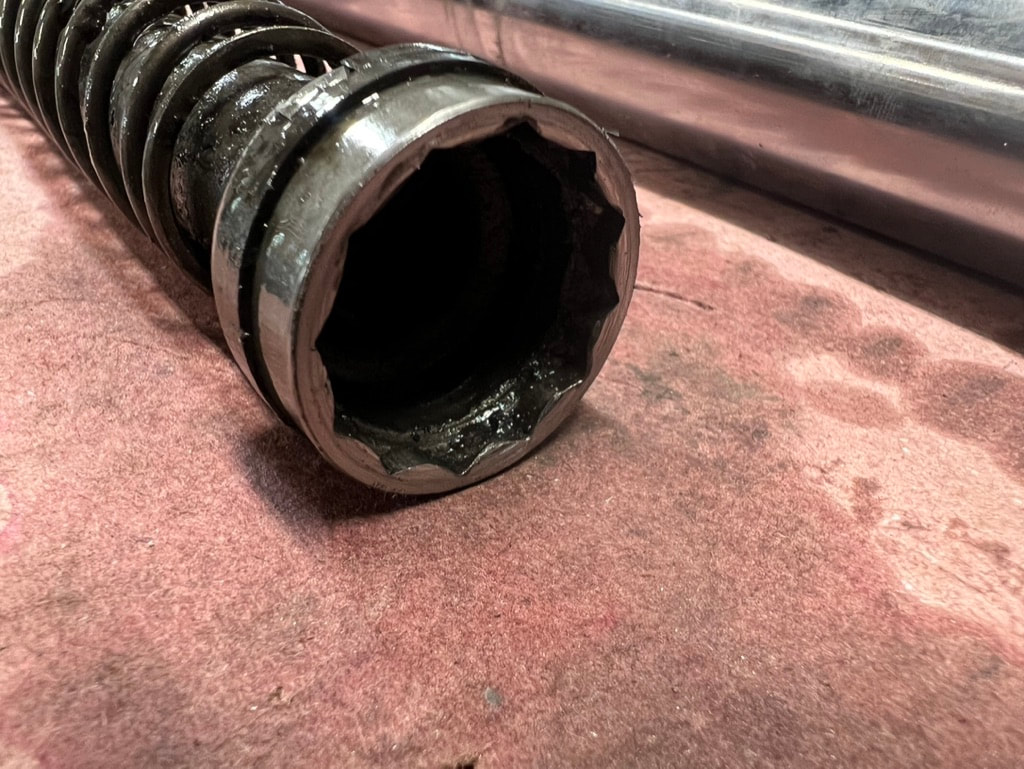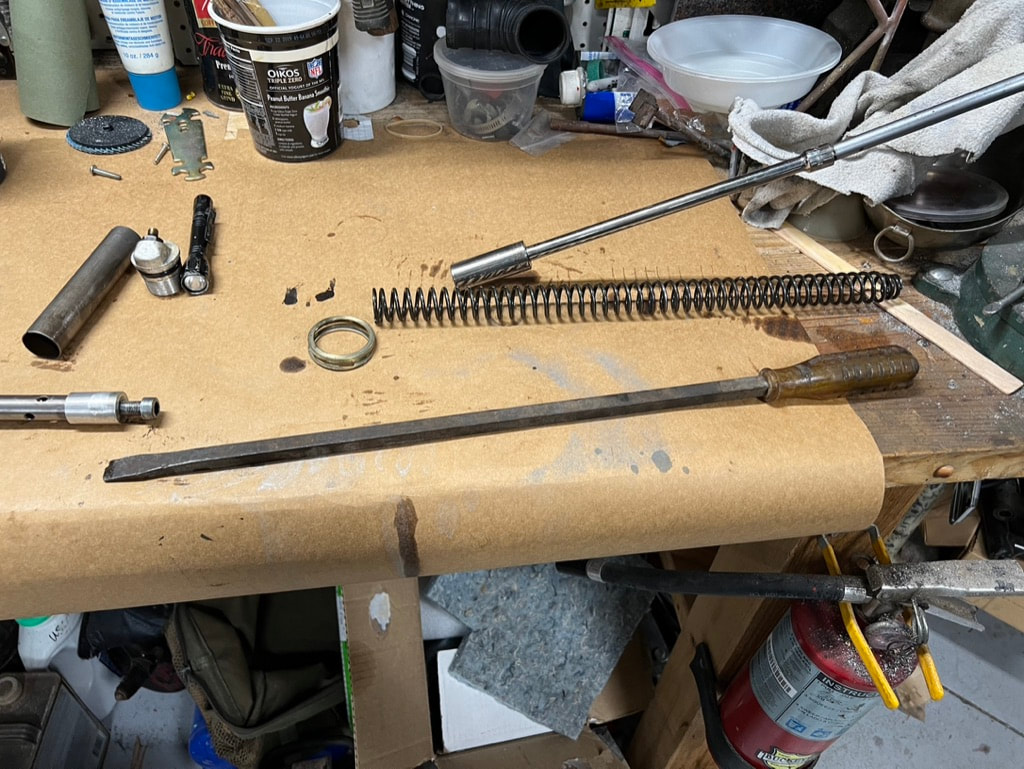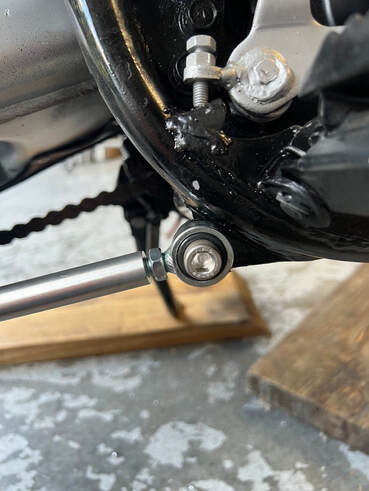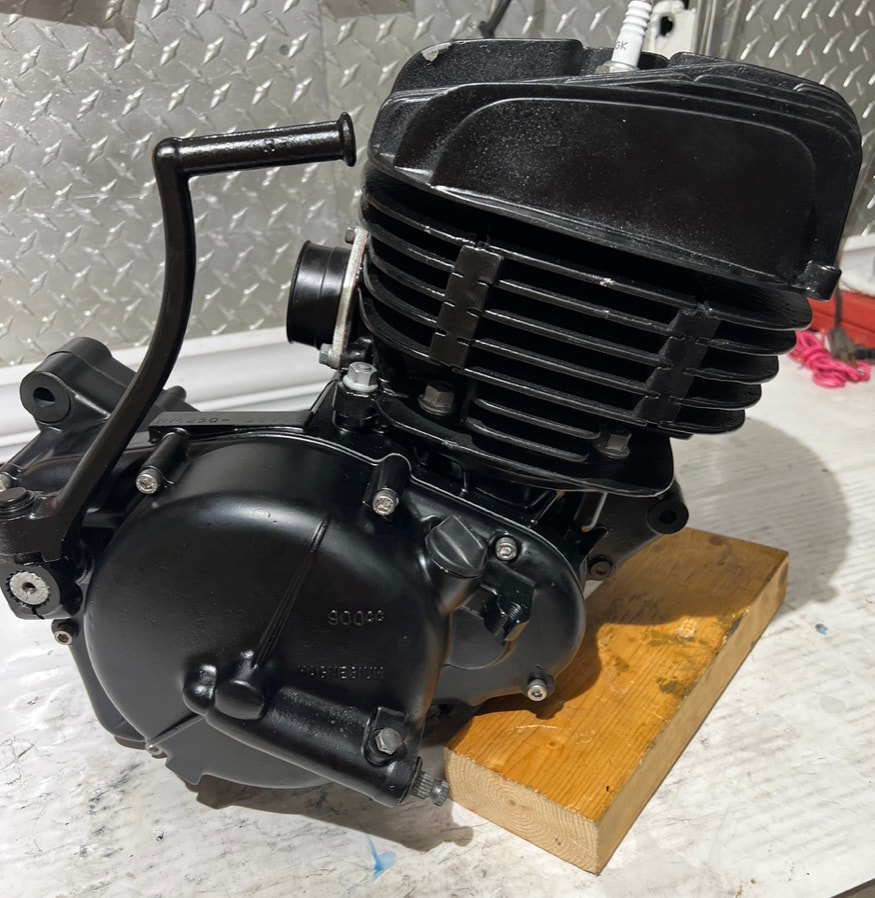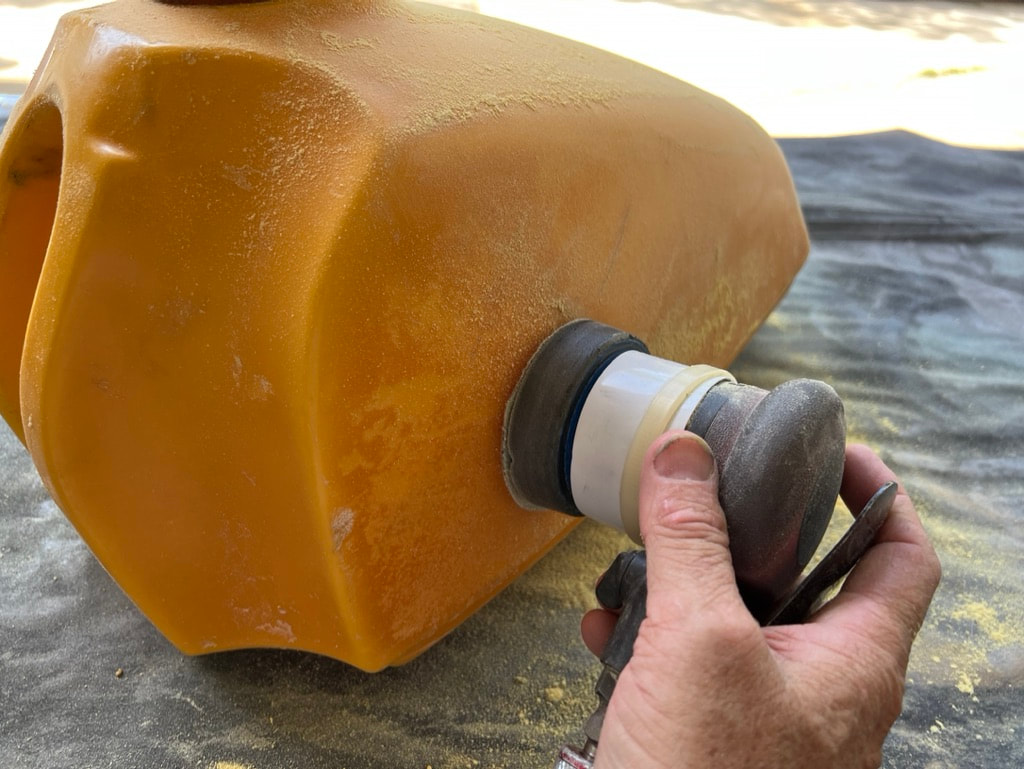1978.5 RM250 C2 Restoration
Energy and perseverance conquers all things - Benjamin Franklin
The sad life of a retired motocross bike
The life of a motocross bike is frequently short and full of abuse. Once new showroom models arrive with the promise of lighter weight, longer-travel suspension and almost always, more power, the usefulness of the old MX ride rapidly expires. That's because almost all MX racers blame their losses on their bikes not being competitive enough, rather than placing the blame on their lack of skill or luck. Believe me, there is nothing dignified about the death of an MX motorcycle. Such was the case with this 1978 RM250.
In 1976, a completely redesigned RM250 was released, and, for a almost a year, it was the dominate Japanese motorcycle in the 250cc class. Completely unlike it's predecessor, this new machine offered great handling and an abundance of smooth power. For several years, Suzuki factory racers, Roger De Coster and Joel Robert, had been racking up wins and championships in the open class in Europe and this new RM promised the same for 250cc riders in the US. But, in 1978, Yamaha and their technologically-advanced monoshock racer, soon started racking up wins. It wasn't long before Suzuki engineers were lamenting their short stay at the top. So these busy engineers began to improve the bike they had just improved and they did it at a very rapid pace. In just twelve short months, Suzuki would release 4 new models of the same motorcycle in less than one year. Something completely unheard of in the transportation industry and the singular reason this restoration would prove so difficult. More on that later.
In 1976, a completely redesigned RM250 was released, and, for a almost a year, it was the dominate Japanese motorcycle in the 250cc class. Completely unlike it's predecessor, this new machine offered great handling and an abundance of smooth power. For several years, Suzuki factory racers, Roger De Coster and Joel Robert, had been racking up wins and championships in the open class in Europe and this new RM promised the same for 250cc riders in the US. But, in 1978, Yamaha and their technologically-advanced monoshock racer, soon started racking up wins. It wasn't long before Suzuki engineers were lamenting their short stay at the top. So these busy engineers began to improve the bike they had just improved and they did it at a very rapid pace. In just twelve short months, Suzuki would release 4 new models of the same motorcycle in less than one year. Something completely unheard of in the transportation industry and the singular reason this restoration would prove so difficult. More on that later.
 A sad start to a happy ending!
A sad start to a happy ending!
This damaged and dilapidated Suzuki was transported to Florida from New York in startling humility, sharing the bed with of load of firewood. The once stylishly beautiful aluminum tank was heavily dented, seat cover torn, the frame twisted in the rear from a wheelie gone horribly awry. Tires and tubes were rotted and flat. The engine was spent and worn out, most parts beyond repair. The Mikuni carb had been replaced with a Keihin carb off a Honda CR125 and it didn't even fit the intake boot. Expensive magnesium cases were cracked and corroded. The sprocket cover was missing, as was the CDI controller, coil, silencer and front number plate. The front and rear suspension were completely shot, and whatever oil was left in them was dripping from rotted seals. The seat foam was disintegrating and the cover held together with duct tape. The handlebars were bent and the body plastic was crusty and cracked. This was a dubious, but not completely unfamiliar beginning for an MX restoration. I have at least 3 other former racers (1969 Harley Baja, a 1971 Rickman 125 and a 1984 GS495 KTM) in the shop waiting for restoration, and they're all in similar condition. Regardless of how this restoration began, this bike meant something to Todd and his brothers, as well as to Richard. It was a once a gleaming yellow link to their youth and it was my job to recreate that memory.
Back in May of 2023, I had just finished a restoration of Todd’s CT70 and after delivering the bike, Todd asked me if I was up to restoring his RM. I admit I didn’t take a good look at the bike until it hit my shop. As it turned out, this was to be one of my most challenging restorations, topped only by my own childhood ride, a 1969 Harley Rapido. Both bikes qualified as scrap-heap restoration projects.
|
I guess I have Richard Ruck to thank (or to blame) for this involved project. Richard is a very skilled builder of custom bikes. Even though he rode RM Suzukis as a kid, these days he prefers V-Twins over little two strokes. I met Richard through a mutual friend, long-time customer and award-winning builder, Jared Weems. A while back, Richard was looking for someone to vapor blast parts for a bike he was working on. But, he also needed someone willing to get his buddy's CT70 running. And if all that worked out, there might be a RM250 project down the road. It turns out Todd was that buddy. He's a childhood friend. They went to the same schools and lived near each other while growing up in the Catskills area of New York. Now, many years later, they're neighbors in Florida, and they both still love motorcycles.
|
 That's me on a 78 RM250 attempting a pass to take the lead while under the lights at Eagle's TT/MX course in Tampa, circa 1980. I loved racing at night. It was only in the high 80s most nights during the summer. Daytime racing was unbearable, but we did it anyway.
That's me on a 78 RM250 attempting a pass to take the lead while under the lights at Eagle's TT/MX course in Tampa, circa 1980. I loved racing at night. It was only in the high 80s most nights during the summer. Daytime racing was unbearable, but we did it anyway.
It's interesting that Richard, Todd and I all rode the same model Suzuki. I raced a 1978 RM125 as well as the RM250 (pictured). I also owned a nearly new, 1980 RM125, but that was stolen from my garage which also completely ended my racing career. At the time, I was just year or so out of high school and was making a few bucks race prepping, painting and wrenching on motorcycles. I quickly found, I was more talented at keeping bikes running than leading races. So I retired from racing (for a while) and started wrenching full time (also for a short while) before I headed to college full time and eventually a new career that had almost nothing to do with motorcycles.
So, back to the restoration. This bike was a particularly daunting challenge and here's why: Originally, the idea was to restore the RM to its standard 1978 250-A configuration. But when Richard discovered we needed new engine cases, the only good cases he could find were off a rare, C2 model. He did a little research and realized that the C2 was a way cooler and much rarer motorcycle. How rare? Well, we found that out the hard way.
So, back to the restoration. This bike was a particularly daunting challenge and here's why: Originally, the idea was to restore the RM to its standard 1978 250-A configuration. But when Richard discovered we needed new engine cases, the only good cases he could find were off a rare, C2 model. He did a little research and realized that the C2 was a way cooler and much rarer motorcycle. How rare? Well, we found that out the hard way.
Back in the day, I was working on RM250s at least once a week. I am still very familiar with this A-model RM (the one delivered to me) but I never had a chance to ride or to work on the rarer C-2 model. I also was completely unaware of how many changes had been made to the original A-model until I began researching this bike for the restoration. The previous model to our finished product was the C-model. This powerful ride was much closer to the bikes ridden by Suzuki factory racers than the original A-model. The C model had much more travel in the forks and shocks, heavier-duty triple trees and risers; new handle bars; front number plate, a large plastic tank, as well as different fenders. The list is long, but the C-2, released just a short time later, offered additional performance-enhancing changes. The mid-year release of the 250 C-model garnered a lot of good press for Suzuki. The suspension wasn't as technologically advanced as Yamaha's monoshock, but it worked better. And the power delivery from the engine to the rear wheel was predicable and smooth. Suzuki had built a game-changer, but the Suzuki R&D team wasn't finished.
Suzuki, Honda, Kawasaki and Yamaha all understood that winning championships equated to a huge boost in sales of both off-road and street motorcycles at their dealerships. The year this bike was built was a tough one for Suzuki. They had been dominant on the world stage with Joel Robert and Roger De Coster winning championships in Europe, but suddenly found themselves rapidly loosing ground to Yamaha and their wonderfully talented stable of riders in the US. So in 1978, Suzuki decide to shake things up by making four model changes in less than eight months. Most manufactures don't make four model changes in ten years. Back then, MX was king. Game-changing advancements like mono-shocks, aluminum swingarms, disc brakes, long-travel forks, magnesium engine cases and remote reservoir shocks were flying out of the R&D departments and onto the track almost as quickly as they were being thought up by the company's engineering staff. These rapid advancements had a dramatic effect on the future of motorcycling. These were the glory days of motorcycle development and the impact from these technological advances can be seen in almost every motorcycle produced today.
There is a lot of sketchy and conflicting information from the time, but from what I can gather, this is a brief synopsis of the tornadic timeline for the 1978 RM250. At the beginning of 1978, the Suzuki showrooms are stocked with A-models, which were released in 1977. Remember the A-model was the motorcycle delivered to me by Todd and Richard. But even as the A-model was being sold in February, the new B-models were already making their way to dealerships. The B-model was released with an improved expansion chamber and a lighter rear wheel. Then, a month or so later, the C-Model was introduced with a bevy of changes. It offered longer-travel forks, new triple trees and risers, new front brake, new shocks and a shiny new aluminum swingarm. Even more noticeable than the beefy swingarm was the squarish plastic tank which replaced one of the most beautiful tank designs ever in motocross. The plastic tank wasn't even lighter than the aluminum tank. but it was new. It offered a slightly higher capacity, not even needed for MX racing, but I guess it might have appealed to desert racing folks. The C-model fenders were larger and sported ridges for strengthening. You would think this would be enough mid-year changes for any motorcycle manufacturer, but apparently the R&D team at the time begged to differ.
Before the 1979 models were released, one more change was made for 1978, and this was the nifty C-2. This bike was so advanced from the A-model, an article about the release of the bike in CycleWorld was titled, The Best RM Yet: Take it Out of the Crate and Win! The C-2 shared newer, beefier, longer-travel forks (shared with the 79 model), a new conical-hub front wheel (the 79 had a full-width hub like the factory racers), new longer-travel shocks, and a slightly altered, smoother power-plant. There were also several minor changes to the frame. All the changes were warranted and it did help sell motorcycles, but it made this restoration much more difficult and much expensive for Todd. That’s because C-2 parts are exquisitely rare and are not only really hard to find, but they’re also almost always more expensive than standard RM parts. But what is really crazy was in 1979, Suzuki made a whole bunch more changes to things they had just changed. Crazy, right?
So I mentioned that replacement parts (in any usable condition) were harder to find and often more expensive than A-model parts. Did I mention the forks came from Germany? The correct triple trees from Canada? The swingarm from Canada too? After months of looking and almost giving up, I found the shocks hanging from the rafters of my buddy's shop. And a few weeks later, he called me to let me know he'd been kicking around a silencer in his dark storage trailer. It was an almost-impossible-to-find silencer in really bad shape, but it was the real deal, not an aftermarket product. There are so many twists and turns with this story I could write a book. Thank goodness Richard found most of the parts for me, but finding all those critical components took months. That's why this 3-month restoration stretched into 8 months.
The wrap up:
The long search for the correct C-2 parts was difficult, expensive and frustrating, but I hope it never dampened Richard or Todd's enthusiasm for the project. Richard was absolutely invaluable when it came to helping me acquire the correct parts for this project. He was also a great source of encouragement throughout this journey.
One thing I am certain of, both of these guys had huge smiles on their faces when they first saw the finished project.
When they heard it fire up for the first time, those smiles somehow became even bigger. It seems this bright yellow link to their past had transported them back to the day when things were just a little simpler and a bunch more fun.
The long search for the correct C-2 parts was difficult, expensive and frustrating, but I hope it never dampened Richard or Todd's enthusiasm for the project. Richard was absolutely invaluable when it came to helping me acquire the correct parts for this project. He was also a great source of encouragement throughout this journey.
One thing I am certain of, both of these guys had huge smiles on their faces when they first saw the finished project.
When they heard it fire up for the first time, those smiles somehow became even bigger. It seems this bright yellow link to their past had transported them back to the day when things were just a little simpler and a bunch more fun.
Project Video
Above is a video documenting the process of this restoration.
First start and test ride of our RM250 C2 project bike
Converting an A, B or C-model to a C-2
In case anyone is wondering what it takes to convert an A-model RM250 into the C-2 model, the simple answer is, a lot. With our restoration, there were a few things we were unable to convert. The exhaust was one of them. We still haven't been able to find one with the specific C-2 pedigree. We also replaced the original equipment CDI with an aftermarket unit. That was also the case with the aluminum, rear brake stabilizer.
If you like challenges and you're interested in making this conversion, there are several things you'll have to do to the frame once you have all the parts and that's because, there are some parts that just won't work if you don't.
If you like challenges and you're interested in making this conversion, there are several things you'll have to do to the frame once you have all the parts and that's because, there are some parts that just won't work if you don't.
Let's begin with the front end. That's because this area caused the most issues for us. Once you get the C-2 forks, you'll notice they don't have a 36mm OD, as do the A-model forks. So, they won't fit the A, B or C-model triple trees (aka steering stem). By the way, if you install the C or C-2 aluminum swingarm without changing to the correct forks, you'll feel like you're always riding downhill on the bike. Once you install the forks, you'll need to make some changes to both the C-2 steering stem (lower) and the frame. To use this stem with an A, B or C-model frame, you'll need to fabricate a spacer for the center stem. That's because the steering stem is just a bit longer. You will also need to shave the center stem shaft down about 1mm so the 1978 upper bearing and race will fit the stem. If you try this conversion, you'll end up using a '78 bearing and race on the top and a '79 race and bearing kit on the bottom. You will not find a C-2 bearing kit anywhere. We were able to get the bearings we need through All Balls Racing. The reason for the two bearings is because the factory changed the neck of the frame slightly. Oh yeah, when you go to rebuild the forks, you'll need a special tool that will fit around the nut used to hold the internal slider to the lower leg.
Once you have the new forks installed on the new trees, you'll notice the lower steering stem no longer makes contact with the steering stops on the frame. You will need to cut off the old stops, fabricate new stops and weld them on. I wish I had known this before I painted the frame. The '79 seals will fit the C-2 model forks. I believe the only difference between the two is the tab just below the lower fork boot clamp. On the C-2 model, the front brake cable guide is built into the clamp. On later models, the guide bolts directly to the left fork leg and is not a part of the clamp. You'll also have some difficulty finding fork boots that fit. I found only one supplier that came close to the originals. I used measurement to make sure they would fit. One other thing about the risers for the C-2 model: the fender mounts are not identical. So, you will either have an extra set of holes if you use the same fender, or you'll want to buy a new '79 model fender (without holes) and drill them with the correct spacing for the C-2 lower stem. Speaking of fenders, the C-2 fenders are identical to the 79 model. They have raised ridges and are larger.
Once you have the new forks installed on the new trees, you'll notice the lower steering stem no longer makes contact with the steering stops on the frame. You will need to cut off the old stops, fabricate new stops and weld them on. I wish I had known this before I painted the frame. The '79 seals will fit the C-2 model forks. I believe the only difference between the two is the tab just below the lower fork boot clamp. On the C-2 model, the front brake cable guide is built into the clamp. On later models, the guide bolts directly to the left fork leg and is not a part of the clamp. You'll also have some difficulty finding fork boots that fit. I found only one supplier that came close to the originals. I used measurement to make sure they would fit. One other thing about the risers for the C-2 model: the fender mounts are not identical. So, you will either have an extra set of holes if you use the same fender, or you'll want to buy a new '79 model fender (without holes) and drill them with the correct spacing for the C-2 lower stem. Speaking of fenders, the C-2 fenders are identical to the 79 model. They have raised ridges and are larger.
The fuel tank and aluminum swingarm are the most easily noticeable changes between the models. The A and B-models use the beautiful, aluminum tank while the C and C-2 models use the plastic tank. That tank is also the same as the '79 model. But, if you get them from some suppliers, you'll notice the paint doesn't match the tank. We painted our fender so they did match.
The swingarm also created a few challenges for us. We found the rear wheel chain adjusters from A-model (steel swingarm) will not fit the C-model, aluminum swingarm. They are different sized with different spacers, but the bolts are the same. The steel and aluminum swingarms also do not share the same bushings. To adapt a C-2 swingarm to the A or B-model frame, you'll need to fabricate a spacer for the rear wheel and, if I remember correctly, for the swing arm bolt too.
The swingarm also created a few challenges for us. We found the rear wheel chain adjusters from A-model (steel swingarm) will not fit the C-model, aluminum swingarm. They are different sized with different spacers, but the bolts are the same. The steel and aluminum swingarms also do not share the same bushings. To adapt a C-2 swingarm to the A or B-model frame, you'll need to fabricate a spacer for the rear wheel and, if I remember correctly, for the swing arm bolt too.
The C-2 engine is slightly different with a different cylinder. Some parts will not fit between the A-model and C-2 model. Also, the expansion chamber is slightly different. The A-model chamber can be used with the C-2 model engine without causing any significant loss in power.
This may not be a complete list of changes between the A and C-2 models, but it covers all the big issues. The biggest issue with making this model change is, not so much the work involved, as much as just finding the correct parts. The B, C and C-2 models are rare because they are partial year model changes. The C-2 shares a lot of parts with the 1979 model, so that helps a bit. If you're looking to compare parts lists, you'll find the 1979 model does not have any sub-categories, while the 77 and 78 show both the A,B,C and C-2 models. That's not because the B,C and C-2 models were offered during 1977, it was just what current parts manuals show. Again, I say this with a bit of caution, because, I'm sure there is some Suzuki expert out there that has better first-hand knowledge than I do. While I've been around a long time and worked on these bikes over 50 years, I have never claimed to be a particular expert on any motorcycle. Unless you worked in the R&D or engineering dept, or maybe, if you were a factory wrench, you may privy to this type of insider information. If someone knows better and can prove it (I'm sure someone will), please contact me with your information. I always seek to have information on my website correct.
Rick Carr
The Vintage Bike Builder
This may not be a complete list of changes between the A and C-2 models, but it covers all the big issues. The biggest issue with making this model change is, not so much the work involved, as much as just finding the correct parts. The B, C and C-2 models are rare because they are partial year model changes. The C-2 shares a lot of parts with the 1979 model, so that helps a bit. If you're looking to compare parts lists, you'll find the 1979 model does not have any sub-categories, while the 77 and 78 show both the A,B,C and C-2 models. That's not because the B,C and C-2 models were offered during 1977, it was just what current parts manuals show. Again, I say this with a bit of caution, because, I'm sure there is some Suzuki expert out there that has better first-hand knowledge than I do. While I've been around a long time and worked on these bikes over 50 years, I have never claimed to be a particular expert on any motorcycle. Unless you worked in the R&D or engineering dept, or maybe, if you were a factory wrench, you may privy to this type of insider information. If someone knows better and can prove it (I'm sure someone will), please contact me with your information. I always seek to have information on my website correct.
Rick Carr
The Vintage Bike Builder
